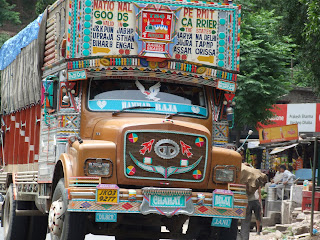
Nearly everyday since we have been here we have been diverted from our planned route with rickshaw drivers, taxis, and even touts in the street pushing us to their local handi craft emporioums. How ever many times you politely refuse their demand to visit one of these tourists traps; you still end up in one. Indians just don't listen!!! Everything is commission based, that's how it works here. In Delhi; in one such place we were escorted around an emporioum (close to the Lotus Temple) in a well rehearsed, and efficient procedure. Almost as though there were one way directional arrows marked on the floor. After you have seen one of these shops (often with wonderful names e.g Paradise Carpets), you have seen them all.
However, today we went to the other side of lake Dal (thank heavens our boat is not moored there; if lake Nageen is comparible to a sleepy village, then Dal is more like Delhi.
Lake Nageen is calm and tranquil. Back to carpets.
So our driver today took us to a Co-op carpet company, and what a pleasant surprise. Of course the salesman wanted to get a sale, and infact he really deserved it. He showed us a carpet weaver at work, and shared with us such interesting information:
Carpets are made from silk, wool, artifical fibre or a mixture of all. How to check that a silk carpet is exactly that. Pull out a fibre and light it. If it smells like burnt hair, or a feather, then it's genuine. If it melts and smells then it's artifical.
The 3 main makers of carpets are from Turkey (Marocco), Kashmir(Persia) and India. The most important thing to look for when buying a carpet (apart from colour and pattern, and material) are the types of knot. A Turkish carpet uses an 'S' knot, an Indian carpet uses a 'U' knot, and a Kashmire carpet uses a figure '8' knot. Hence it is much stronger, and harder to pull out the fibre.
Kashmire carpets come in different qualties, and that depends mainly on how many knots are (hand) tied per square inch. The knots for silk carpets vary from maximum 600 knots per square inch to 256 per sq inch. The knots for wool carpets vary from 324 knots per sq inch to 200 knots per sq inch.
Therefore it takes a loan carpet weaver 4 and a half years to weave a 6 foot by 9 foot silk carpet at 600 knots per sq inch (highest quality). The weaver in the picture is working on a top quality carpet (6ft - 4ft), and it will take him around 2 years.......8 hours a day. The photo shows a typical Moughal (windowed) design; very similar to decorations in the Taj Mahal.
How do I know all this? It's been really useful to always carry a notebook and pen; from reccommend places to visit ; noting down personal addresses etc...
And how does the weaver remember the pattern? Up until this morning I had no idea. For every carpet a detailed pattern id drawn, and from that pattern a complexed code is drawn up. similar to a book; where each line represents one line of weave in the carpet. I asked the salesman if I coulld grovel behind the weaving device, and I was rewarded by finding a 50cm coded page from 100 years ago. A good souvenir, and a very, very interesting morning.
Last blog.....I think until Leh, unless of course a gipsy in the mountains has computer and internet connection. I just don't think so.

















































